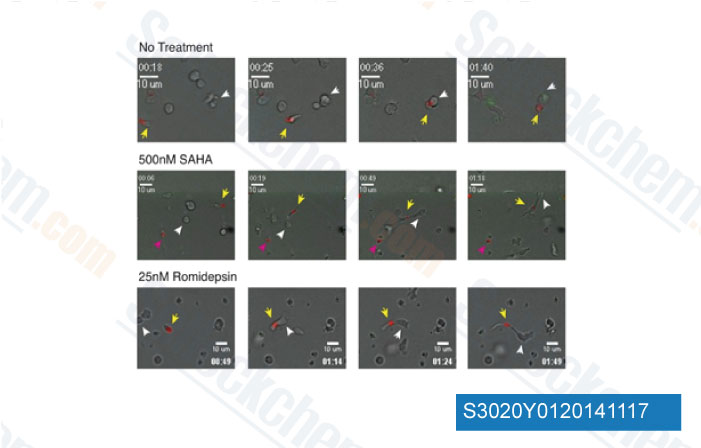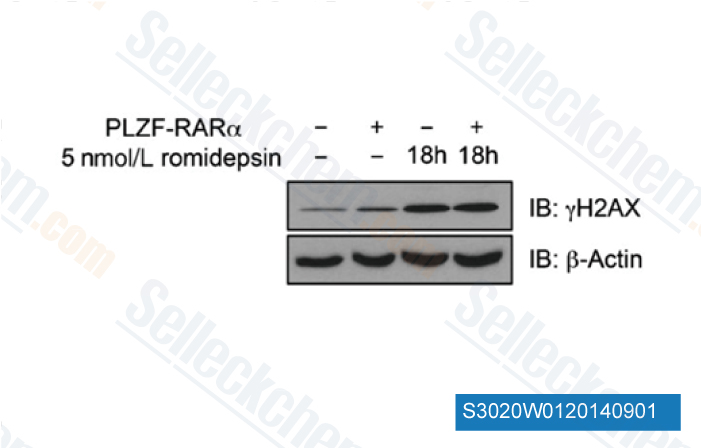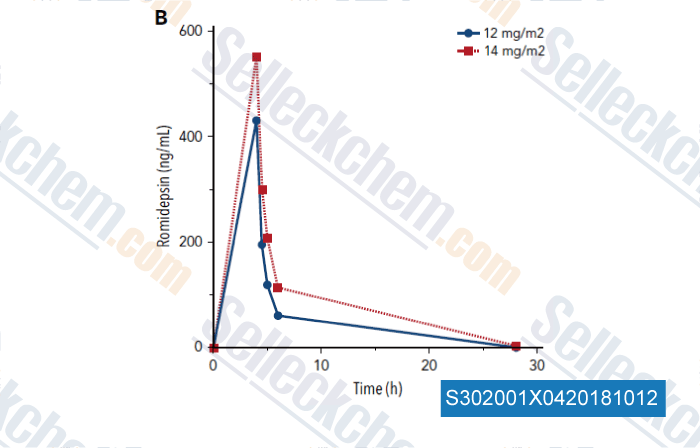|
Toll Free: (877) 796-6397 -- USA and Canada only -- |
Fax: +1-832-582-8590 Orders: +1-832-582-8158 |
Tech Support: +1-832-582-8158 Ext:3 Please provide your Order Number in the email. |
Technical Data
| Formula | C24H36N4O6S2 |
||||||
| Molecular Weight | 540.7 | CAS No. | 128517-07-7 | ||||
| Solubility (25°C)* | In vitro | DMSO | 100 mg/mL (184.94 mM) | ||||
| Water | Insoluble | ||||||
| Ethanol | Insoluble | ||||||
| In vivo (Add solvents to the product individually and in order) |
|
||||||
|
* <1 mg/ml means slightly soluble or insoluble. * Please note that Selleck tests the solubility of all compounds in-house, and the actual solubility may differ slightly from published values. This is normal and is due to slight batch-to-batch variations. * Room temperature shipping (Stability testing shows this product can be shipped without any cooling measures.) |
|||||||
Preparing Stock Solutions
Biological Activity
| Description | Romidepsin (FK228, Depsipeptide, FR 901228, NSC 630176) is a potent HDAC1 and HDAC2 inhibitor with IC50 of 36 nM and 47 nM in cell-free assays, respectively. Romidepsin (FK228/depsipeptide) controls growth and induces apoptosis in neuroblastoma tumor cells. | ||||
|---|---|---|---|---|---|
| Targets |
|
||||
| In vitro | Unlike TSA, the active form redFK of Romidepsin strongly inhibits HDAC1 and HDAC2 with IC50 of 1.6 nM and 3.9 nM, respectively, but is relatively weak in inhibiting HDAC4 and HDAC6 with IC50 25 nM and 790 nM, respectively. Romidepsin is 17-23 times weaker than redFK in inhibiting these HDACs with IC50 of 36 nM, 47 nM, 510 nM, and 14 μM, respectively. Romidepsin treatment in HeLa cells induces histone acetylation and p21 expression with EC50 of 3.0 nM, more strongly than redFK with EC50 of 11 nM due to the instability of redFK. [1] In addition to G2/M arrest, Romidepsin treatment causes cyclin D1 downregulation and a p53-independent p21 induction, leading to inhibition of CDK and dephosphorylation of Rb resulting in growth arrest in the early G1 phase. [2] Romidepsin is 100 times more potent than TSA and 1,000,000 times more potent than butyrate in inhibiting the proliferation of the A549 cells. [3] Romidepsin inhibits the growth of U-937, K562, and CCRF-CEM cells with IC50 of 5.92 nM, 8.36 nM, and 6.95 nM, respectively. [5] Romidepsin promotes apoptosis in chronic lymphocytic leukemia (CLL) cells at a concentration corresponding to that at which H3 and H4 acetylation and HDAC inhibition occurs, selectively involving activation of caspase 8 and effector caspase 3, as well as down-regulation of c-FLIP protein. [6] In 11 of 13 (85%) renal cell carcinoma cell lines and in 16 of 37 (43%) other cancer cell lines, Romidepsin treatment up-regulates tumor death receptors, and potentiates natural killer (NK)-mediated tumor killing. [7] Romidepsin exhibits concentration-dependent cytotoxicity against a panel of mantle cell lymphoma (MCL) cell lines. [9] | ||||
| In vivo | Romidepsin treatment potently inhibits the neovascularization of chick embryo and that of adult mice in the Matrigel plug assay. [4]Administration of Romidepsin at 0.1-1 mg/kg twice a week significantly prolongs the survival of mice bearing U-937 lymphoma, with median survival times of 30.5 (0.56 mg/kg) and 33 days (0.32 mg/kg), respectively (vs. 20 days in control mice). [5] | ||||
| Features | More effective than other classical HDAC inhibitors such as TSA, TPX, and butyrate. |
Protocol (from reference)
| Kinase Assay: |
|
|---|---|
| Cell Assay: |
|
| Animal Study: |
|
References
Customer Product Validation

-
Data from [Int J Cancer, 2014, 135(12):2950-61]

-
Data from [Data independently produced by PLoS Pathog, 2014, 10(8), e1004287]

-
Data from [Mol Cancer Ther, 2013, 12(8), 1591-604]

-
Data from [Data independently produced by , , Blood, 2018, 131(4):397-407]
Selleck's Romidepsin has been cited by 251 publications
| Extracellular Histones as Exosome Membrane Proteins Regulated by Cell Stress [ J Extracell Vesicles, 2025, 14(2):e70042] | PubMed: 39976275 |
| Gadd45g insufficiency drives the pathogenesis of myeloproliferative neoplasms [ Nat Commun, 2024, 15(1):2989] | PubMed: 38582902 |
| Epigenetic profiles guide improved CRISPR/Cas9-mediated gene knockout in human T cells [ Nucleic Acids Res, 2024, 52(1):141-153] | PubMed: 37985205 |
| SIN3A histone deacetylase action counteracts MUS81 to promote stalled fork stability [ Cell Rep, 2024, 43(2):113778] | PubMed: 38341854 |
| Romidepsin and afatinib abrogate JAK-STAT signaling and elicit synergistic antitumor effects in cutaneous T-cell lymphoma [ J Invest Dermatol, 2024, S0022-202X(23)03210-4] | PubMed: 38219917 |
| Targeting CD25+ lymphoma cells with the antibody-drug conjugate camidanlumab tesirine as a single agent or in combination with targeted agents [ Br J Haematol, 2024, 10.1111/bjh.19658] | PubMed: 39080847 |
| Exosomal membrane proteins analysis using a silicon nanowire field effect transistor biosensor [ Talanta, 2024, 278:126534] | PubMed: 39002259 |
| The Methyltransferases METTL7A and METTL7B Confer Resistance to Thiol-Based Histone Deacetylase Inhibitors [ Mol Cancer Ther, 2024, 23(4):464-477] | PubMed: 38151817 |
| New synergistic combination therapy approaches with HDAC inhibitor quisinostat, cisplatin or PARP inhibitor talazoparib for urothelial carcinoma [ J Cell Mol Med, 2024, 28(9):e18342] | PubMed: 38693852 |
| An epigenetic mechanism of social isolation stress in adolescent female mice [ Neurobiol Stress, 2024, 29:100601] | PubMed: 38213831 |
RETURN POLICY
Selleck Chemical’s Unconditional Return Policy ensures a smooth online shopping experience for our customers. If you are in any way unsatisfied with your purchase, you may return any item(s) within 7 days of receiving it. In the event of product quality issues, either protocol related or product related problems, you may return any item(s) within 365 days from the original purchase date. Please follow the instructions below when returning products.
SHIPPING AND STORAGE
Selleck products are transported at room temperature. If you receive the product at room temperature, please rest assured, the Selleck Quality Inspection Department has conducted experiments to verify that the normal temperature placement of one month will not affect the biological activity of powder products. After collecting, please store the product according to the requirements described in the datasheet. Most Selleck products are stable under the recommended conditions.
NOT FOR HUMAN, VETERINARY DIAGNOSTIC OR THERAPEUTIC USE.
